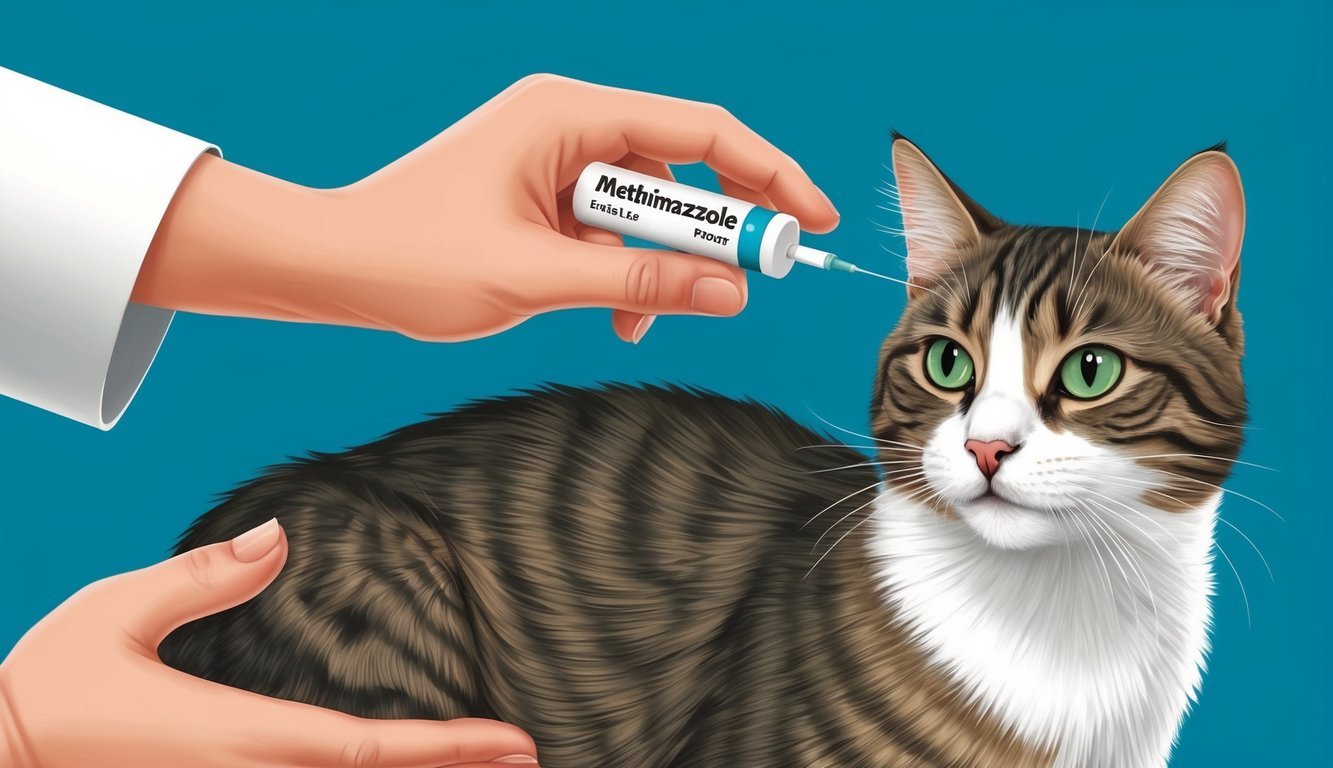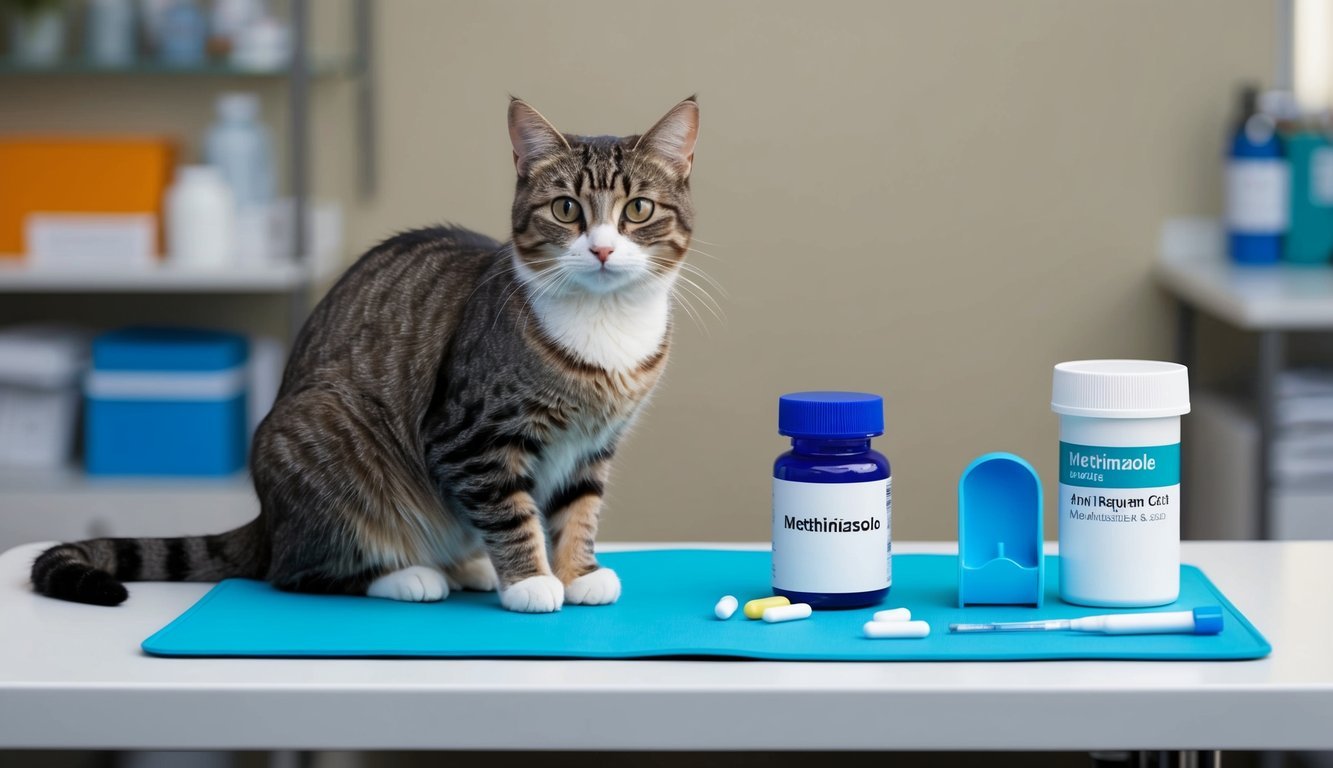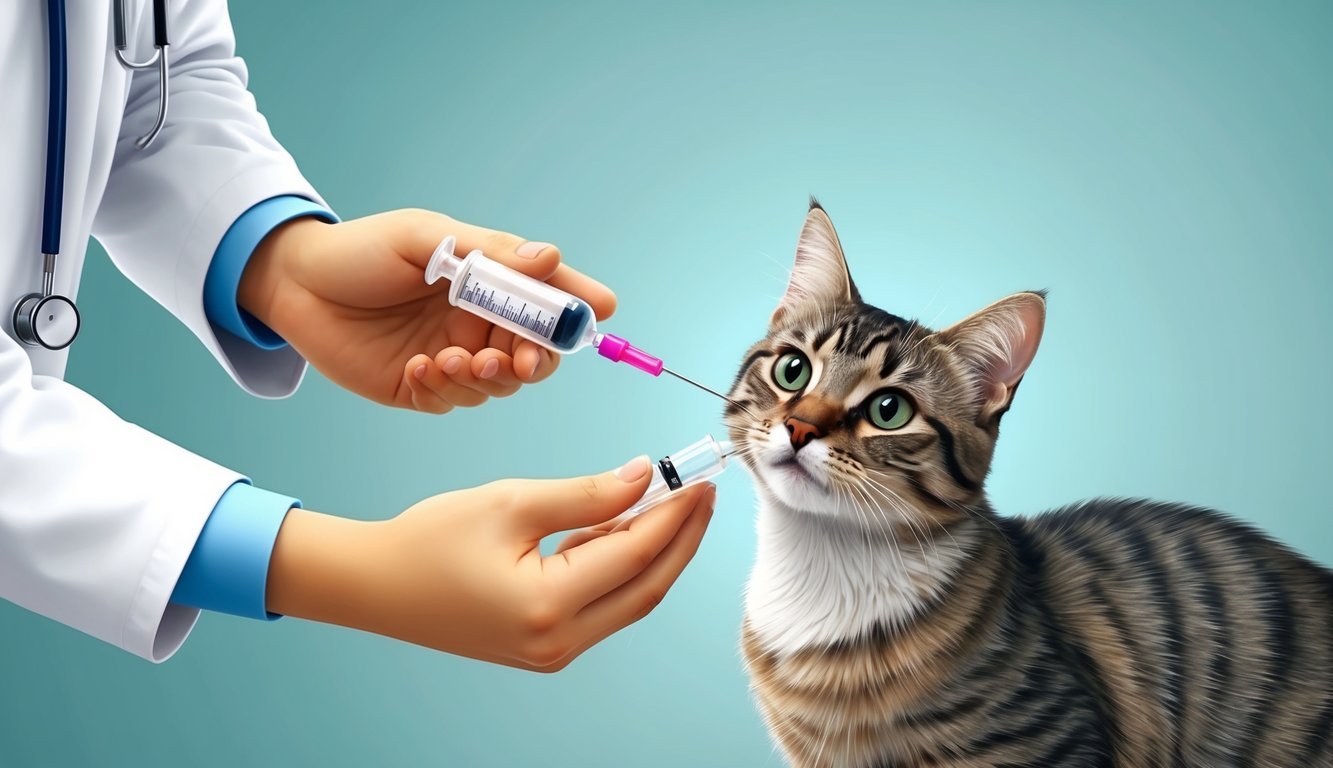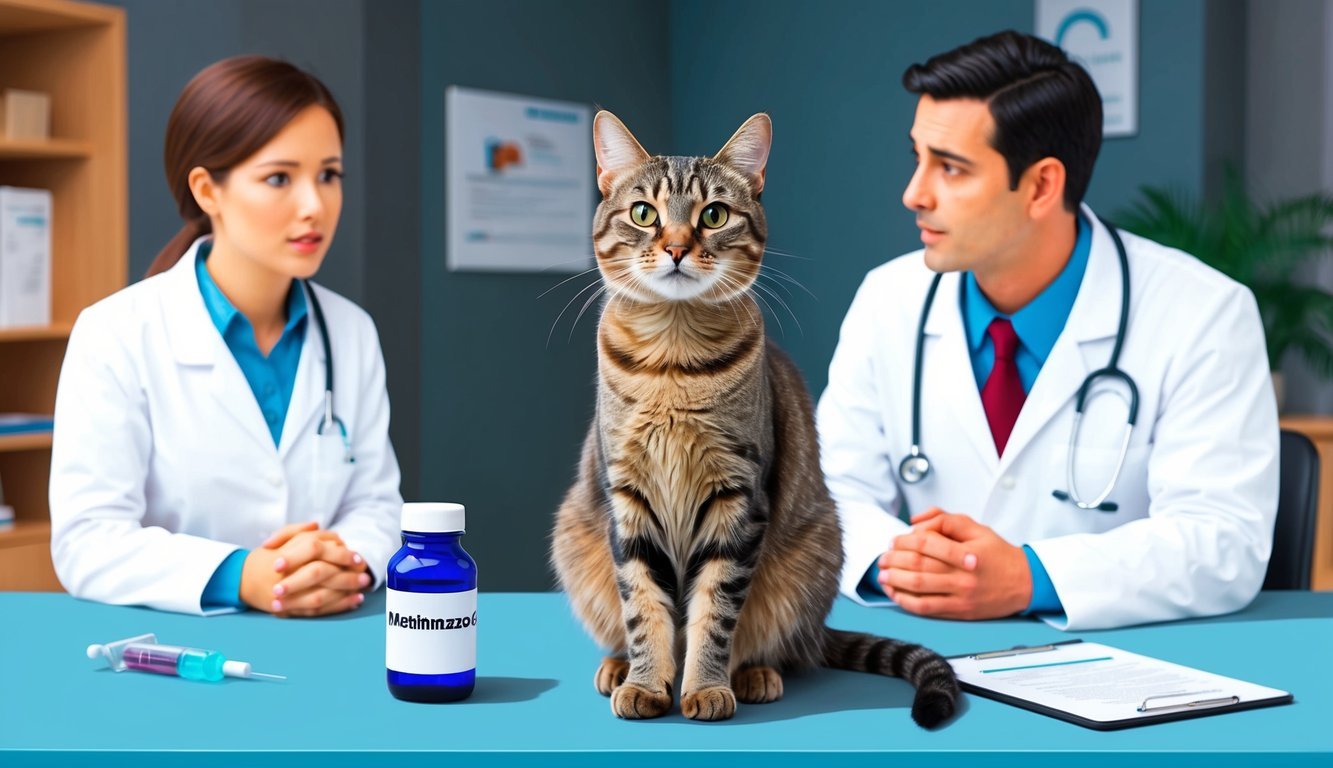Methimazole is an important medication that helps manage hyperthyroidism in cats, a common condition affecting older felines. Understanding how methimazole works can significantly improve your cat’s quality of life.
This antithyroid medication blocks the production of thyroid hormones, offering relief and stability for your furry friend.
As a pet owner, it’s essential to know how to administer methimazole effectively and to be aware of the potential side effects.
With the right information and resources, you can navigate this treatment successfully and keep your cat feeling its best.
You’ll also explore other treatment options available, ensuring you make the best choice for your pet’s health.
Whether you’re already familiar with methimazole or just starting to research it for your cat, this guide will provide valuable insight into living with feline hyperthyroidism and the role medication plays in managing this condition.
Key Takeaways
- Methimazole is crucial for treating hyperthyroidism in cats.
- Knowing how to administer the medication can ease your cat’s condition.
- Awareness of side effects helps in managing your cat’s health.
Understanding Feline Hyperthyroidism

Feline hyperthyroidism is a common endocrine disorder primarily affecting older cats.
This condition is characterized by the excessive production of thyroid hormones, which can lead to a range of health issues if left unmanaged.
Causes and Diagnosis
The main cause of hyperthyroidism in cats is typically an adenoma, a benign tumor that develops on the thyroid gland.
In some cases, an autoimmune disease can also provoke this hormonal imbalance.
Diagnosis usually involves a veterinarian performing blood tests to measure thyroid hormone levels.
Your vet may also conduct a physical examination and evaluate the cat’s history of symptoms.
Recognizing the early signs can lead to more effective treatment and management.
Regular check-ups are important, especially for aging felines, to monitor their hormone levels and overall health.
Symptoms of Hyperthyroidism in Cats
You may notice various signs if your cat is hyperthyroid.
Common symptoms include:
- Weight Loss: Despite a normal or increased appetite, your cat may lose weight.
- Increased Thirst and Urination: Excess thyroid hormones can elevate thirst levels, leading to frequent urination.
- Vomiting: This can occur due to gastrointestinal upset.
- Lethargy: You might observe a decline in their usual energy levels.
Additionally, you may see a change in behavior, like increased hyperactivity or restlessness.
If you notice these signs, consult your veterinarian for further evaluation and management options.
Methimazole Overview

Methimazole is an antithyroid medication commonly prescribed for cats diagnosed with hyperthyroidism.
It helps manage the condition by inhibiting the production of thyroid hormones.
Understanding how this medication works and the various forms available can help you make informed decisions about your cat’s health.
How Methimazole Works
Methimazole functions by blocking the enzyme thyroperoxidase, which plays a crucial role in the synthesis of thyroid hormones.
By inhibiting this enzyme, methimazole effectively reduces the production of thyroxine (T4) and triiodothyronine (T3), the hormones involved in regulating metabolism.
This is particularly beneficial for cats, as hyperthyroidism can lead to weight loss, increased appetite, and other serious health issues.
Monitoring your cat’s thyroid hormone levels is essential when on this medication.
Regular blood tests ensure the drug is effectively managing the condition without causing adverse effects, such as gastrointestinal upset or lethargy.
Forms of Methimazole
Methimazole is available in various forms, primarily as oral tablets and transdermal gels.
Felimazole is a brand specifically designed for cats, available in 2.5 mg and 5 mg tablets.
It is FDA-approved, making it a reliable choice for feline hyperthyroidism.
Another option is the transdermal gel, which you can apply to your cat’s ear.
This form can be advantageous for cats that resist oral medications.
Prior to the availability of Felimazole, human formulations like Tapazole were often used off-label for felines.
Talking to your veterinarian will help you choose the best method suitable for your cat’s preferences and needs.
Administering Methimazole to Cats
Administering methimazole involves determining the correct dosage and closely monitoring your cat’s response to the treatment.
Understanding these aspects will help ensure your cat’s health while managing feline hyperthyroidism effectively.
Determining the Right Dosage
Your veterinarian will prescribe the appropriate dosage of methimazole based on your cat’s condition, weight, and response to treatment.
Methimazole is typically available in oral tablets, with doses commonly ranging from 2.5 mg to 5 mg.
Your vet may start with a lower dosage and adjust it based on blood tests that check T4 levels.
These tests help ensure that the thyroid hormone levels are controlled without causing adverse effects.
Using a prescription diet can also complement treatment, as certain diets may help manage hyperthyroid symptoms.
Always follow your vet’s instructions regarding dosage and administration times for the best outcomes.
Monitoring Treatment
Regular monitoring is crucial while your cat is on methimazole.
Your veterinarian will recommend periodic blood tests to check T4 levels and assess thyroid function.
In addition, monitoring your cat for side effects is important.
Common side effects include vomiting and lethargy, particularly during the first few months of treatment.
Be vigilant about changes in your cat’s behavior and appetite.
Your vet may also recommend checking blood cell counts to ensure that the medication does not negatively impact your cat’s health.
Regular follow-ups will help tailor the treatment plan effectively, keeping your feline friend comfortable and healthy.
Side Effects and Management
Managing your cat’s treatment with methimazole involves being aware of potential side effects and knowing how to address them.
Understanding these aspects can help ensure your cat remains healthy while undergoing therapy for feline hyperthyroidism.
Common Side Effects
Methimazole can lead to several common side effects in cats.
You might notice your cat experiencing vomiting, anorexia (loss of appetite), and excessive tiredness or lethargy shortly after starting the medication.
These gastrointestinal effects often manifest within the first few months of treatment and may affect around 10% of cats.
While many cats tolerate methimazole well, it’s essential to monitor their behavior.
If your cat shows signs of nausea or decreased energy, it could indicate a reaction to the medication.
Keeping a close eye on your pet can help catch any issues early.
Serious Complications
In some cases, methimazole can cause serious complications, although these are less common.
Potential risks include liver disease, kidney disease, and blood disorders.
Symptoms to watch for include jaundice (yellowing of the skin or eyes), unusual bleeding, or changes in urine output.
If you notice any of these signs, it’s crucial to take action.
These complications can pose significant health risks and require immediate veterinary attention.
Understanding the signs can help you respond promptly and effectively, ensuring your cat receives the best possible care.
When to Contact a Veterinarian
You should reach out to your veterinarian if you observe any concerning changes in your cat’s health.
Signs of a possible problem might include persistent vomiting, severe lethargy, or noticeable changes in appetite.
Additionally, if your cat displays symptoms like excessive drooling or difficulty breathing, consider it a veterinary emergency.
Regular check-ups are also essential while your cat is on methimazole.
Your vet can monitor liver and kidney function through blood tests and adjust dosages as necessary.
Open communication with your veterinarian ensures that your cat’s treatment remains safe and effective.
Other Treatment Options

When managing hyperthyroidism in cats, you have several alternatives to consider beyond methimazole.
These options can vary in effectiveness based on your cat’s specific health needs and conditions.
Combination Therapies
Combination therapies may enhance treatment effectiveness by using multiple approaches.
In some cases, veterinary professionals prescribe antithyroid medications like methimazole alongside other drugs.
For instance, beta-blockers may be utilized to manage symptoms like rapid heart rate.
Other medications like digoxin, phenobarbital, or theophylline can also play a role in managing concurrent conditions.
It’s essential to have your veterinarian evaluate these combinations closely, ensuring they fit your cat’s health profile and lifestyle.
Advanced Therapies
Advanced therapies offer more targeted solutions for hyperthyroidism.
Radioiodine treatment involves administering radioactive iodine, which selectively destroys overactive thyroid tissue.
This option is often considered curative, and many cats experience long-lasting relief.
Thyroid surgery is another advanced approach, particularly for cases where other treatments haven’t been effective or if there are specific anatomical concerns.
Both therapies require specialized care and monitoring, so discussing these options with your veterinarian can help determine the best fit for your feline friend.
Living with Hyperthyroidism
Managing feline hyperthyroidism requires a focus on diet, lifestyle adjustments, and consistent veterinary care.
Understanding how to support your cat will enhance their quality of life.
Diet and Lifestyle Changes
Adjusting your cat’s diet is crucial when managing hyperthyroidism.
A prescription diet designed for thyroid health can help regulate their condition.
These diets often contain reduced iodine, which can limit thyroid hormone production.
Keep mealtime consistent.
Small, frequent meals can also help manage your cat’s appetite and energy levels.
It’s important to monitor their weight closely; sudden weight loss could indicate the need for medical adjustments.
Additionally, providing a low-stress environment is vital.
Cats are sensitive to changes, so maintaining a routine can ease anxiety.
Engaging in gentle play can keep them active without overwhelming them.
Long-Term Management
Long-term management of hyperthyroidism often involves regular veterinary check-ups.
These visits allow for monitoring thyroid levels and adjusting medications like methimazole as needed.
Your veterinarian may also screen for related conditions, such as hypertension or diabetes mellitus, which can arise due to prolonged hyperthyroidism.
If needed, your vet may recommend additional treatments or adjust your cat’s medication.
It’s essential to administer any prescribed medications on schedule.
Missing doses could lead to fluctuations in hormone levels, affecting your cat’s health.
Stay informed and proactive about the signs of complications, such as increased thirst or urination, which could indicate other health issues.
Regular communication with your veterinarian will help in the ongoing management of your cat’s condition.
Pharmacological Considerations
When considering methimazole for your cat, it’s important to understand how the medication works.
Methimazole is a type of benzimidazole that inhibits thyroid hormone production.
This can help manage hyperthyroidism effectively.
Dosage is critical.
Typical starting doses are 2.5 mg of methimazole taken twice daily.
Always follow your veterinarian’s guidance on administering the correct dosage.
Keep an eye on your cat’s side effects.
Some common issues include:
- Vomiting
- Loss of appetite
- Lethargy
These effects usually occur within the first three months of treatment.
If you notice severe side effects, contact your vet immediately.
Monitoring is essential.
Regular veterinary check-ups help assess your cat’s response to methimazole.
Blood tests may be required to ensure hormone levels are within the desired range.
On occasion, antiparasitics may interact with methimazole.
Always inform your vet of any other medications your cat is taking to avoid complications.
Finally, consider lifestyle factors.
Diet plays a role in how effective methimazole can be.
Feeding high-quality food might help your cat tolerate the medication better.
Frequently Asked Questions

Many cat owners have questions about methimazole, especially regarding its side effects, dosage, and costs.
Understanding these aspects will help you manage your cat’s treatment effectively.
What are the common side effects of giving my cat methimazole?
Common side effects of methimazole include vomiting, loss of appetite, and lethargy.
Some cats may also experience skin rashes or liver issues.
It’s crucial to monitor your cat for any changes and consult your veterinarian if you notice concerning symptoms.
How can I tell if my cat is receiving too high of a dose of methimazole?
Signs of a potentially high dose include excessive vomiting, lethargy, or changes in behavior.
More severe reactions can include jaundice or difficulty in breathing.
If you suspect an overdose, contact your veterinarian immediately for guidance.
What’s the recommended dosage of methimazole for a cat with hyperthyroidism?
The typical starting dosage for methimazole in cats is about 2.5 mg to 5 mg, given twice daily.
Your veterinarian will likely adjust the dose based on your cat’s response and thyroid hormone levels, so regular check-ups are essential.
How much does methimazole treatment for cats typically cost?
The cost of methimazole can vary.
Generally, the medication itself may range from $20 to $50 a month, depending on your cat’s dosage and the supplier.
Additional costs may include veterinary visits for blood tests and monitoring.
Are there any topical application methods for methimazole for my feline friend?
Yes, methimazole is available in a transdermal form that can be applied to your cat’s ear.
This option can be beneficial for cats that are difficult to medicate orally.
Your veterinarian will provide guidance on how to properly apply the medication.
Are there any alternatives to methimazole if my cat cannot tolerate it?
If methimazole is not suitable, your vet may suggest alternatives.
These include radioactive iodine treatment or surgical thyroidectomy.
Some cats might also be offered dietary management options.
However, these approaches vary in availability and effectiveness.

